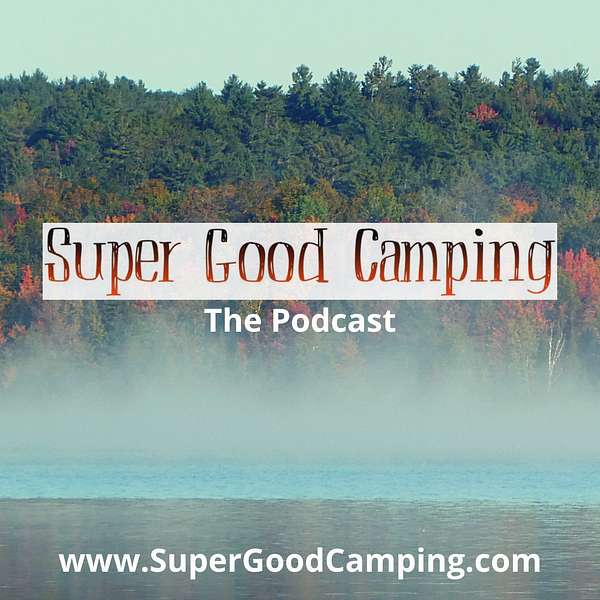
Super Good Camping Podcast
Hi there! We are a blended family of four who are passionate about camping, nature, the great outdoors, physical activity, health, & being all-around good Canadians! We would love to inspire others to get outside & explore all that our beautiful country has to offer. Camping fosters an appreciation of nature, physical fitness, & emotional well-being. Despite being high-tech kids, our kids love camping! We asked them to help inspire your kids. Their creations are in our Kids section. For the adults, we would love to share our enthusiasm for camping, review some of our favourite camping gear, share recipes & menus, tips & how-to's, & anything else you may want to know about camping. Got a question about camping? Email us so we can help you & anyone else who may be wondering the same thing. We are real people, with a brutally honest bent. We don't get paid by anyone to provide a review of their product. We'll be totally frank about what we like or don't like.
Super Good Camping Podcast
Zebra mussels aren’t souvenirs, and firewood isn’t a travel buddy
A quiet invasion is reshaping Ontario’s lakes, forests, and wetlands—and most of the spread is accidental. We break down the top invasive species threatening biodiversity and outdoor recreation, then share smart, simple steps every camper, paddler, angler, and hiker can take to stop the damage. From zebra mussels and round goby to emerald ash borer, Asian longhorned beetle, garlic mustard, buckthorn, purple loosestrife, and dog‑strangling vine, we explain how each species changes habitat, why it matters for fish nurseries and forest health, and what early warning signs to look for on the water and along the trail.
You’ll hear practical field tips you can use right away: clean, drain, and dry boats and gear; never move live bait between waterbodies; don’t transport firewood; and learn to spot D‑shaped exit holes in ash or dense reed stands of invasive phragmites. We also talk reporting tools like EDDMapS Ontario, working with certified arborists, and joining local stewardship days to pull invasive plants and restore native groundcover. Along the way, we share personal stories of tree loss, park closures, and shoreline changes that show how fast an infestation can turn a favourite campsite or launch into a very different place.
If you love paddling clear bays, fishing healthy lakes, and hiking under diverse canopies, this is your action plan. Let’s protect our shared backyard with consistent habits and early reporting so conservation teams can act fast. Enjoyed the conversation and want more practical outdoor tips? Follow, rate, and share the show with a friend who camps Ontario—then tell us your invasive‑species sightings and wins.
CONNECT WITH US AT SUPER GOOD CAMPING:
Support the podcast & buy super cool SWAG: https://store.skgroupinc.com/super_good_camping/shop/home
EMAIL: hi@supergoodcamping.com
WEBSITE: www.supergoodcamping.com
YOUTUBE: https://www.youtube.com/channel/UCqFDJbFJyJ5Y-NHhFseENsQ
INSTAGRAM: https://www.instagram.com/super_good_camping/
TWITTER: https://twitter.com/SuperGoodCampin
FACEBOOK GROUP: https://www.facebook.com/groups/SuperGoodCamping/
TIKTOK: https://www.tiktok.com/@supergoodcamping
Hello and good day. A welcome to the Super Good Camping Podcast. My name is Pamela.
SPEAKER_00:I'm Tim.
SPEAKER_01:We are from Supergoodcamping.com. We're here because we want a mission to inspire other people to get outside and enjoy camping adventures such as we have. Today we want to talk about Ontario's top ten invasive species and what you can do as outdoors people to try to help prevent or repair the damage. First off, we've got some aquatic species. So zebra mussels are number one on the list. They're small freshwater mollusks, which are not the yummy kind of mollusks. They're just the destructive kind of mollusks that attach to hard surfaces and they filter large amounts of water disrupting food supplies for other other species.
SPEAKER_00:Next is the round goby. It's an aggressive bottom dwelling fish that competes with native species and consumes fish eggs.
SPEAKER_01:Not the caviar kind.
SPEAKER_00:Probably not. I don't think we have caviar in the Great Lakes.
SPEAKER_01:Invasive fragmites, which is the common reed. It's a tall wetland grass that forms dense colonies and crowds out native wetland plants.
SPEAKER_00:Eurasian water milfoil. Am I doing that right? I think so. All right. Submerged aquatic plant that forms dense mats. Oh, yeah, I know what we're talking about. It impedes water recreation and fish habitat.
SPEAKER_01:Yeah. And then we've got some forest or terrestrial species. Not extraterrestrial, but terrestrial. Emerald Emerald Emerald Ashbor is an invasive beetle from Asia, first discovered in Ontario in 2002, that has killed millions of ash trees by tunneling through their vascular systems. From what I recall about ash trees, is they are very connected and underneath the ground. Like what you see as a big forest or stand of ash trees might actually be all one organism. Yeah, yeah, yeah.
SPEAKER_00:And the other the other bad one with so we had an ash tree out front, had past tents. Yeah, the systems have to be cut just so that they don't so we could uh limit the spread because that's terrible now.
SPEAKER_01:Yeah, my brother had too, and they had to cut down a big beautiful one in their backyard.
SPEAKER_00:Yeah. It makes for less ashwood for Corey and Maria to uh to make paddles of, I'd just say. Uh Asian longhorn beetle attacks hardwood trees, including maples, poplars, birches, and willows. I think that's what they had to cut a bunch down at Kilbear for. Don't hold me to it.
SPEAKER_01:Um we'd been there before that, and then shortly after we were there.
SPEAKER_00:We saw, yeah, we saw saw pictures of of like entire parking lots stacked to the to the to the roof, but but huge, huge stacks of just uh uh I hundreds and hundreds of trees, maybe even thousands of trees. I don't know. Just crazy. Uh actually Thomas and I saw oh, we're going back maybe half a dozen years uh on a trip to Algonquin. We saw Asian longhorns. Oh, we also saw some in uh in Killarney, which is just terrible.
SPEAKER_01:Uh garlic mustard, which sounds delicious, but I think it's not such a good plant. Um herbaceous plant that threatens hardwood forests and impacts native wildflowers like white trillium, which is our beautiful provincial flower in Ontario.
SPEAKER_00:Uh number eight, per purple loose strife. It's a wetland plant that displaces native vegetation in marches, mark marches, in marshes and wetlands.
SPEAKER_01:And I have to I have to recall my father being very concerned about purple loose strife, and it's got to be 40 years ago now. Yeah. Uh buckthorn is a shrub that forms dense thickets and forests and displace displaces native undersury plants. So anything that's underneath the canopy.
SPEAKER_00:Here's a nasty sounding one. Dog strangling vine.
SPEAKER_01:Yeah, keep your dog safe.
SPEAKER_00:Climbing vine that threatens monarch butterfly habitat and native plant communities.
SPEAKER_01:So, in general, as far as trying to prevent this happening, prevention, I guess, anatropathic doctor prevention is always the goal. Um, so general prevention is keep things clean and drain and dry. So if you're using a boat uh or a trailer or fishing equipment, when you're moving between bodies of water, make sure that there's nothing attached, like especially the zebra mussels attached to the bottom of your boat and drain it if there's liquid in there and um making sure that your fishing equipment is also not transporting either vegetation or zebra mussels or something from one body of water to another.
SPEAKER_00:Yeah, I just I I'm sure I saw a story either earlier this week or or maybe maybe the week before, where just a just a standard, you know, pull them over, check them, check them out. Somebody was taking a boat from one province to another, uh, a little farther out west, and uh when they checked the bridge, they found zebra mussels. Ah so that would have been I'm sure that that happens, unfortunately, but get rid of the stowaways. Yep. Uh so oh, so don't move firewood. Uh that there's your emerald ash borer and the uh Asian Longhorn Beetle. Uh the Canadian Food Inspection Agency prohibits movement of firewood and and ash materials outside designated areas due to emerald ash borer.
SPEAKER_01:And report sightings. So if you happen to spot something that looks like it might be an invasive species, use apps like EDDMAPS, EdMaps, Ontario, or contact local conservation authorities to report new invasive species.
SPEAKER_00:I'm pretty sure I can't think of what the app is, but I'm pretty sure I've got one that will identify uh native Ontario species. Um it also identifies invasive ones.
SPEAKER_01:If you happen to have Google Ends, that'll that'll do the trick too.
SPEAKER_00:Yeah, assume well I'm also assuming you have connection because a lot of times we go places that don't for that reason entirely. Uh aquatic species. Inspect and remove visible plant materials and animals from boats, trailers, and equipment. Never transport live fish or use them as bait in different water bodies. Which, yes, I I seem to have recall reading that somewhere because I we used to use minerals when we were kids. I tend to use worms now or twinkly uh tackle, but uh yeah, don't don't uh no more minerals. Avoid disturbing sediment in infested areas and clean anchors. Oh, good one, and fishing lines thoroughly.
SPEAKER_01:Terrestrial plants, so learn to identify invasive plants and avoid purchasing them for your garden. Uh clean your hiking boots, vehicles, and equipment when moving between natural layers because seeds might be stuck in the mud on your bottom of your boots and then you're moving the seeds around. Participate in organized removal events for species like garlic mustard and buckthorn, and choose native plant alternatives for your landscaping.
SPEAKER_00:Forest pests. So follow quarantine regulations for moving wood materials. Uh support biological control programs were available, which would be probably not terribly dissimilar to don't move plants from here, you know, try try to keep your boots clean, don't take seeds with you even. Monitor tree trees for early signs of infestation and work with certified arborists for proper tree management.
SPEAKER_01:And then take community action. So uh join local stewardship programs and invasive species removal programs. Here, like we've got a friends of group in the in the neighboring ravine. So they will do they'll do uh walks, nature walks, and just point out what different plants are, but they also will do um cleanup events like um Earth Day kind of cleaning up literature. But they also will do uh where they'll go through and try to help remove some of the invasive species, um, or friends of groups like Friends of Algonquin, those I'm sure that's probably there's a lot of uh conservation areas that have friends of groups as well. Uh educate others about identification and prevention, support municipal and provincial invasive species management initiatives, and follow action plans developed by Ontario's invasive species programs. So the key is is early detection, rapid response, and ideally prevention in the first place, um, by everybody that uses outdoors because that's all it's our playground. We like to keep it safe.
SPEAKER_00:We do darned invasive poopy heads. Go back where you came from.
SPEAKER_01:Uh that's it for us for today. Thank you so much for listening, as always. If you would like to connect with us, we're on all the social media, and you can always email us. We are at high at supergoodcamping.com. That's hi at supergoodcamping.com. If you have any questions, feedback, concerns, and or if you have some ideas of things you'd like us to talk about. We'll talk to you again soon. Bye. Bye.
Podcasts we love
Check out these other fine podcasts recommended by us, not an algorithm.

Casual Camping Podcast
Casual Camping Podcast

.jpg)